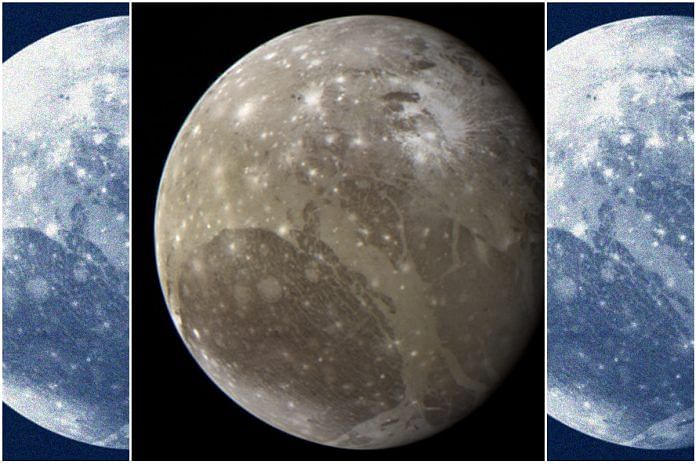Bengaluru: While water is all around us on this planet, there is a celestial body, far, far away from Earth, that may have more water than all of our oceans combined. Jupiter’s largest moon, Ganymede, holds the largest volume of water in our solar system, and is the destination of the European Space Agency’s JUICE mission.
ESA’s Jupiter Icy Moons Explorer is flying to the three largest Jovian moons (Jupiter’s moons) — Ganymede, Callisto, and Europa, all of which have large underground oceans of liquid water, making them potentially habitable.
Postponed by a day, reportedly because of lightning risk, the spacecraft was launched Friday from Europe’s spaceport in Kourou, French Guiana, atop the Ariane 5 rocket.
It is scheduled to reach the Jupiter system eight years from now, in July 2031, and enter into Ganymede’s orbit in 2034.
JUICE will be the first mission to orbit a moon other than Earth’s. It will also overlap with NASA’s Europa Clipper mission, which will launch in 2024 and study Europa.
Also Read: On Jupiter’s icy moon Europa, shallow pools of underground salt water offer promise of life
Icy crusts, endless oceans
JUICE will perform detailed observations while orbiting Ganymede to understand its potential to support life. It will also study Europa and Callisto through flybys.
The mission’s objectives include studying the icy crusts and mapping the surfaces of the moons, characterising the layers of subsurface oceans and understanding their evolution, studying the atmosphere of Ganymede, and observing its magnetic field’s interaction with Jupiter’s.
The spacecraft will be on the lookout for organic molecules that make up life, especially on Europa.
Astrophysicists are especially excited about this mission as this is the first dedicated mission to study promising liquid water worlds in the solar system, and life — as we know it — requires water to survive.
The spacecraft carries eleven science instruments built by engineers from Europe, USA, and Japan. These include camera systems, spectrometers and spectrographs, laser altimeter and ice-penetrating radar, magnetometer, radio interferometers, and more.
Ganymede, Europa, and Callisto make up three of the four Galilean moons. The fourth, Io, is fully covered in volcanoes and will not be a direct target of study for this mission, although JUICE is expected to photograph and observe it from a distance.
The mission will also make observations of smaller, irregular, and undefined satellites.
Spacecraft to reach Ganymede orbit by Dec 2034
The spacecraft carries 3,000 kg of fuel to power it through eight years of journey. It will reach Jupiter after performing multiple gravity assists.
It will fly by the Earth-Moon system in August 2024, Venus in August 2025, a second flyby of Earth in September 2026, and yet another of Earth in January 2029.
The spacecraft will also pass through the asteroid belt twice, with a planned flyby of the asteroid 223 Rosa in October 2029.
Expected to reach the Jovian system in July 2031, JUICE will perform a flyby of Ganymede before first entering into orbit around Jupiter. While still orbiting the planet, it will fly by Europa in July 2032.
Two years from then, in December 2034, JUICE is expected to enter into orbit around Ganymede.
The spacecraft is expected to go through its propellant and deorbit at Ganymede, impacting the moon towards the end of 2035.
Galilean moons
There are 95 known moons of Jupiter with identifiable orbits, and potentially hundreds of smaller, irregular moons.
The four Galilean moons were discovered independently by Galileo Galilei and Simon Marius in 1610. They were the first objects discovered orbiting an object other than the Earth or Sun, as Galileo had just refined the design of the telescope.
The moons are all named after lovers and consorts of the Roman god Jupiter and his Greek counterpart, Zeus.
Ganymede is the largest moon in the solar system, bigger in size than the planet Mercury. It has a liquid iron core, and is the only moon to have its own magnetic field.
It also contains the most volume of water in the solar system — the moon is 46 per cent water, and the total amount of water it holds is thought to be greater than the volume of water on earth.
All three moons have icy crusts and liquid water oceans underneath.
Ganymede’s surface consists of crisscrossed ridges and grooves. Callisto’s surface is said to be the oldest exposed surface in the solar system, covered with impact craters. Meanwhile, Europa has the smoothest surface and likely has ice- or cryovolcanoes.
(Edited by Gitanjali Das)
Also Read: Imagine 34 Mount Everests stacked together — that’s the depth of Jupiter’s Great Red Spot



